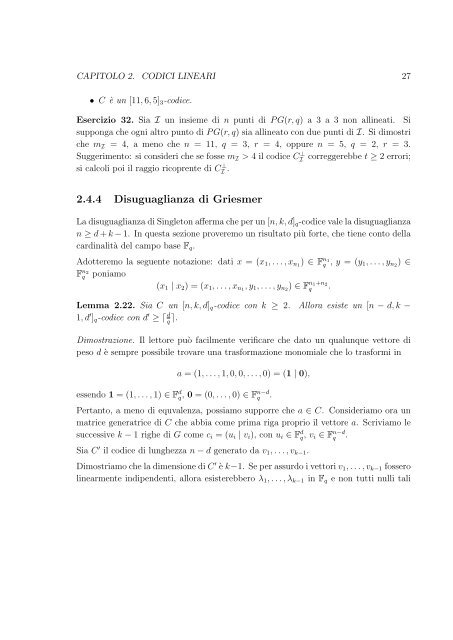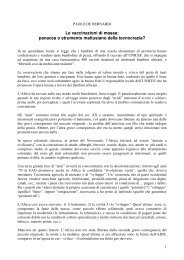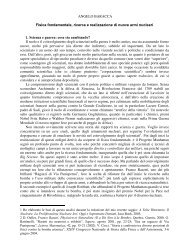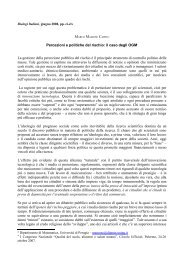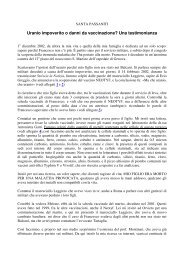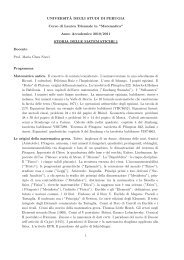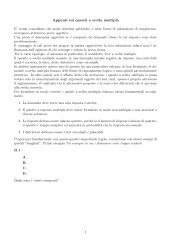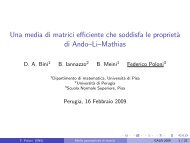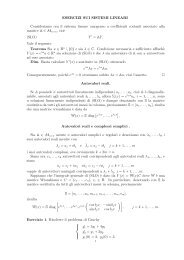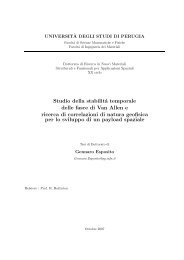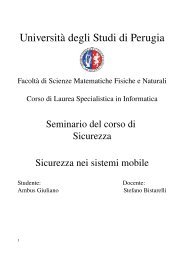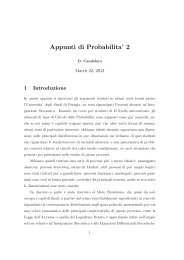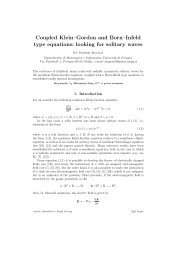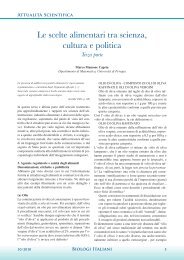Dispense - Dipartimento di Matematica e Informatica
Dispense - Dipartimento di Matematica e Informatica
Dispense - Dipartimento di Matematica e Informatica
You also want an ePaper? Increase the reach of your titles
YUMPU automatically turns print PDFs into web optimized ePapers that Google loves.
CAPITOLO 2. CODICI LINEARI 27<br />
• C è un [11, 6, 5]3-co<strong>di</strong>ce.<br />
Esercizio 32. Sia I un insieme <strong>di</strong> n punti <strong>di</strong> P G(r, q) a 3 a 3 non allineati. Si<br />
supponga che ogni altro punto <strong>di</strong> P G(r, q) sia allineato con due punti <strong>di</strong> I. Si <strong>di</strong>mostri<br />
che mI = 4, a meno che n = 11, q = 3, r = 4, oppure n = 5, q = 2, r = 3.<br />
correggerebbe t ≥ 2 errori;<br />
Suggerimento: si consideri che se fosse mI > 4 il co<strong>di</strong>ce C⊥ I<br />
si calcoli poi il raggio ricoprente <strong>di</strong> C⊥ I .<br />
2.4.4 Disuguaglianza <strong>di</strong> Griesmer<br />
La <strong>di</strong>suguaglianza <strong>di</strong> Singleton afferma che per un [n, k, d]q-co<strong>di</strong>ce vale la <strong>di</strong>suguaglianza<br />
n ≥ d + k − 1. In questa sezione proveremo un risultato più forte, che tiene conto della<br />
car<strong>di</strong>nalità del campo base Fq.<br />
Adotteremo la seguente notazione: dati x = (x1, . . . , xn1) ∈ Fn1 q , y = (y1, . . . , yn2) ∈<br />
Fn2 q poniamo<br />
(x1 | x2) = (x1, . . . , xn1, y1, . . . , yn2) ∈ F n1+n2<br />
q .<br />
Lemma 2.22. Sia C un [n, k, d]q-co<strong>di</strong>ce con k ≥ 2. Allora esiste un [n − d, k −<br />
1, d ′ ]q-co<strong>di</strong>ce con d ′ ≥ ⌈ d<br />
q ⌉.<br />
Dimostrazione. Il lettore può facilmente verificare che dato un qualunque vettore <strong>di</strong><br />
peso d è sempre possibile trovare una trasformazione monomiale che lo trasformi in<br />
a = (1, . . . , 1, 0, 0, . . . , 0) = (1 | 0),<br />
essendo 1 = (1, . . . , 1) ∈ Fd q, 0 = (0, . . . , 0) ∈ Fn−d q .<br />
Pertanto, a meno <strong>di</strong> equvalenza, possiamo supporre che a ∈ C. Consideriamo ora un<br />
matrice generatrice <strong>di</strong> C che abbia come prima riga proprio il vettore a. Scriviamo le<br />
successive k − 1 righe <strong>di</strong> G come ci = (ui | vi), con ui ∈ Fd q, vi ∈ Fn−d q .<br />
Sia C ′ il co<strong>di</strong>ce <strong>di</strong> lunghezza n − d generato da v1, . . . , vk−1.<br />
Dimostriamo che la <strong>di</strong>mensione <strong>di</strong> C ′ è k−1. Se per assurdo i vettori v1, . . . , vk−1 fossero<br />
linearmente in<strong>di</strong>pendenti, allora esisterebbero λ1, . . . , λk−1 in Fq e non tutti nulli tali


